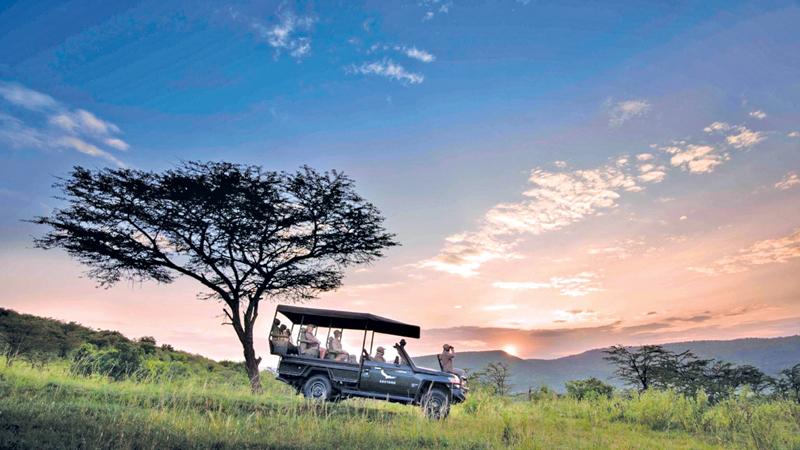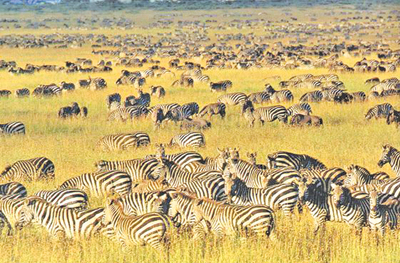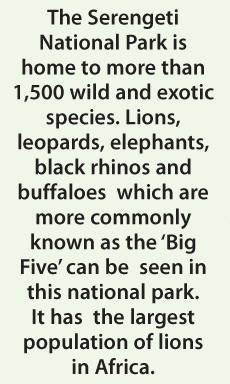
Recently named as one of the seven wonders of Africa the Serengeti National Park is unique in every way. It is also a World heritage site. In this article, Imeth de Silva gives our readers glimpses into Serengiti.
National Parks are territories protected by governments to shelter wild life, their habitats and the environment around them from destruction, human involvement and any other negative impacts.
There are many National Parks all over the world, preserving the breath-taking landscapes, flora and fauna and historical sites around them.
One such National Park, on the North-Central part of Tanzania, is the Serengeti National Park.
Serengeti National Park
 The Serengeti National Park stretches over 14,700 kms or 5,700 square miles. The Maasai is an African tribe who built civilisations along the borders of the River Nile. In their language Siringit means endless plains. Hence, the name was given to the National Park, considering the size of it as the plains and green grasses spread out for miles and miles.
The Serengeti National Park stretches over 14,700 kms or 5,700 square miles. The Maasai is an African tribe who built civilisations along the borders of the River Nile. In their language Siringit means endless plains. Hence, the name was given to the National Park, considering the size of it as the plains and green grasses spread out for miles and miles.
The Serengeti National Park is home to more than 1,500 wild and exotic species. Lions, leopards, elephants, black rhinos and buffaloes which are more commonly known as the ‘Big Five’ can be seen in this national park.
It has the largest population of lions in Africa.
There are also 500 different species of rare birds and many other dangerous predators lurking around the corner.
The ‘Great Migration’
The ‘Great Migration’ is one of the things the Serengeti National Park is famous for. Each year millions of wildebeasts, zebras and gazelles travel North to the Masai Mara National Reserve in Kenya and back to the Serengeti National Park. This is considered as the largest annual animal migration in the world.
However, around a quarter of a million of these animals die whilst migrating due to thirst, hunger, exhaustion and predator attacks.
However, the Serengeti National Park faces many problems which threaten to destroy its long-standing existence. Most of the problems are caused by the usual culprits, the humans.
Poaching and hunting
Poaching and hunting wild life is one of the main problems in this enormous national park. This has a great impact on the wild life, especially the endangered species living in small numbers, despite having survived for millions of years. Human-Wildlife conflicts have increased across the years. When humans start building houses and civilisations on the territory of the national park, the animals start attacking the humans and vice versa.
In addition, population growth is another troublesome situation. When the number of animals start to increase, the ecosystem gets unbalanced and this causes either prey to outnumber predators or vice versa.
This imbalance in nature will lead on to more and more problems in the future.
 Habitat destruction and natural disasters are other problem that damages the national park and causes animals to be dislocated from their respective homes and herds.
Habitat destruction and natural disasters are other problem that damages the national park and causes animals to be dislocated from their respective homes and herds.
Deforestation, which is a common problem among all other National Parks is another major threat to the wild life.
Terrible consequences
These problems can lead to terrible consequences in the future, if we don’t manage it properly.
Therefore, it is vital that governing bodies, who are responsible for the Serengeti National Park to implement rules to ban poaching and hunting in the preserved wild life areas and arrest all the wrongdoers and give them the punishments they deserve.
Solutions
Solutions should also be found to minimise conflict between humans and animals and to ensure the safety of both parties.
If these problems go unsolved, the wild life that has been preserved for so long will undoubtedly come to an end and the habitats and the landscape will be destroyed along with them.
This would cause devastating impacts not only on Tanzania, but all over the world as well, because National Parks contribute greatly towards the balance of nature and keeping the carbon dioxide and oxygen ratio in the air balanced.
If there were no National Parks, the planet would get hotter day by day and thousands of species who live today wouldn’t survive at all.
Destruction to National Parks will lead to mass extinction and ecological degradation.
World Heritage Site
The Serengeti National Park has a vast ecosystem and one of the largest predator-prey interactions in the world. It was named as a UNESCO World Heritage Site in 1979 and was recently declared as one of the seven natural wonders of Africa.
Therefore, it is our primary responsibility as humans to protect these national parks at all costs and to preserve them for future generations to come.
We should all contribute as much as we can to save the animals living in these parks and to save the nature and the surroundings that we admire the most.

